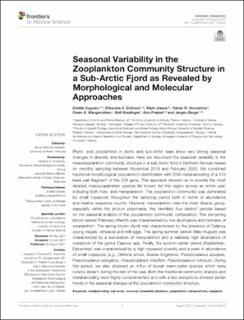| dc.contributor.author | Coguiec, Estelle | |
| dc.contributor.author | Ershova, Elizaveta | |
| dc.contributor.author | Daase, Malin | |
| dc.contributor.author | Vonnahme, Tobias R. | |
| dc.contributor.author | Wangensteen, Owen S. | |
| dc.contributor.author | Gradinger, Rolf | |
| dc.contributor.author | Præbel, Kim | |
| dc.contributor.author | Berge, Jørgen | |
| dc.date.accessioned | 2021-11-12T14:30:46Z | |
| dc.date.available | 2021-11-12T14:30:46Z | |
| dc.date.created | 2021-08-16T13:56:01Z | |
| dc.date.issued | 2021 | |
| dc.identifier.citation | Frontiers in Marine Science. 2021, 8 . | en_US |
| dc.identifier.issn | 2296-7745 | |
| dc.identifier.uri | https://hdl.handle.net/11250/2829407 | |
| dc.description.abstract | Phyto- and zooplankton in Arctic and sub-Arctic seas show very strong seasonal changes in diversity and biomass. Here we document the seasonal variability in the mesozooplankton community structure in a sub-Arctic fjord in Northern Norway based on monthly sampling between November 2018 and February 2020. We combined traditional morphological zooplankton identification with DNA metabarcoding of a 313 base pair fragment of the COI gene. This approach allowed us to provide the most detailed mesozooplankton species list known for this region across an entire year, including both holo- and meroplankton. The zooplankton community was dominated by small copepods throughout the sampling period both in terms of abundance and relative sequence counts. However, meroplankton was the most diverse group, especially within the phylum polychaeta. We identified four distinct periods based on the seasonal analysis of the zooplankton community composition. The pre-spring bloom period (February–March) was characterized by low abundance and biomass of zooplankton. The spring bloom (April) was characterized by the presence of Calanus young stages, cirripedia and krill eggs. The spring-summer period (May–August) was characterized by a succession of meroplankton and a relatively high abundance of copepods of the genus Calanus spp. Finally, the autumn-winter period (September–December) was characterized by a high copepod diversity and a peak in abundance of small copepods (e.g., Oithona similis, Acartia longiremis, Pseudocalanus acuspes, Pseudocalanus elongatus, Pseudocalanus moultoni, Pseudocalanus minutus). During this period, we also observed an influx of boreal warm-water species which were notably absent during the rest of the year. Both the traditional community analysis and metabarcoding were highly complementary and with a few exceptions showed similar trends in the seasonal changes of the zooplankton community structure. | en_US |
| dc.language.iso | eng | en_US |
| dc.rights | Navngivelse 4.0 Internasjonal | * |
| dc.rights.uri | http://creativecommons.org/licenses/by/4.0/deed.no | * |
| dc.title | Seasonal Variability in the Zooplankton Community Structure in a Sub-Arctic Fjord as Revealed by Morphological and Molecular Approaches | en_US |
| dc.type | Peer reviewed | en_US |
| dc.type | Journal article | en_US |
| dc.description.version | publishedVersion | en_US |
| dc.source.pagenumber | 26 | en_US |
| dc.source.volume | 8 | en_US |
| dc.source.journal | Frontiers in Marine Science | en_US |
| dc.identifier.doi | 10.3389/fmars.2021.705042 | |
| dc.identifier.cristin | 1926330 | |
| dc.relation.project | Norges forskningsråd: 299554 | en_US |
| dc.relation.project | Norges forskningsråd: 244319 | en_US |
| dc.relation.project | Norges forskningsråd: 300333 | en_US |
| dc.relation.project | Norges forskningsråd: 223254 | en_US |
| cristin.ispublished | true | |
| cristin.fulltext | original | |
| cristin.fulltext | original | |
| cristin.qualitycode | 1 | |


